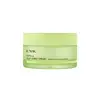What's inside
What's inside
 Key Ingredients
Key Ingredients

No key ingredients
 Benefits
Benefits

 Ingredients Side-by-side
Ingredients Side-by-side

Water
Skin ConditioningGlycerin
HumectantDicaprylyl Ether
Emollient1,2-Hexanediol
Skin ConditioningNiacinamide
SmoothingBetaine
HumectantCaprylic/Capric Triglyceride
MaskingPolyglyceryl-3 Methylglucose Distearate
EmulsifyingPanthenol
Skin ConditioningDimethicone/Vinyl Dimethicone Crosspolymer
Skin ConditioningSodium Carbomer
Emulsion StabilisingHydroxyacetophenone
AntioxidantButylene Glycol
HumectantEthylhexylglycerin
Skin ConditioningCoptis Japonica Root Extract
Skin ConditioningPolyglyceryl-10 Myristate
Skin ConditioningTrisodium Ethylenediamine Disuccinate
Hydrogenated Lecithin
EmulsifyingHydrolyzed Hyaluronic Acid
HumectantCamellia Sinensis Leaf Water
MaskingCentella Asiatica Extract
CleansingFicus Carica Fruit Extract
HumectantGlyceryl Glucoside
HumectantMalachite Extract
AntioxidantArginine
MaskingCeramide NP
Skin ConditioningTocopherol
AntioxidantCarbomer
Emulsion StabilisingSodium Guaiazulene Sulfonate
Opuntia Ficus-Indica Stem Extract
Skin ConditioningWater, Glycerin, Dicaprylyl Ether, 1,2-Hexanediol, Niacinamide, Betaine, Caprylic/Capric Triglyceride, Polyglyceryl-3 Methylglucose Distearate, Panthenol, Dimethicone/Vinyl Dimethicone Crosspolymer, Sodium Carbomer, Hydroxyacetophenone, Butylene Glycol, Ethylhexylglycerin, Coptis Japonica Root Extract, Polyglyceryl-10 Myristate, Trisodium Ethylenediamine Disuccinate, Hydrogenated Lecithin, Hydrolyzed Hyaluronic Acid, Camellia Sinensis Leaf Water, Centella Asiatica Extract, Ficus Carica Fruit Extract, Glyceryl Glucoside, Malachite Extract, Arginine, Ceramide NP, Tocopherol, Carbomer, Sodium Guaiazulene Sulfonate, Opuntia Ficus-Indica Stem Extract
Water
Skin ConditioningGlycerin
HumectantButylene Glycol
HumectantHydrogenated Polydecene
EmollientCaprylyl Methicone
Skin ConditioningBetaine
Humectant1,2-Hexanediol
Skin ConditioningGlycereth-26
HumectantCentella Asiatica Extract
CleansingBeta-Glucan
Skin ConditioningAcrylates/C10-30 Alkyl Acrylate Crosspolymer
Emulsion StabilisingDipotassium Glycyrrhizate
HumectantPvm/Ma Copolymer
Emulsion StabilisingGlyceryl Acrylate/Acrylic Acid Copolymer
HumectantCaprylyl Glycol
EmollientArginine
MaskingXanthan Gum
EmulsifyingHydroxyethyl Acrylate/Sodium Acryloyldimethyl Taurate Copolymer
Emulsion StabilisingEthylhexylglycerin
Skin ConditioningDisodium EDTA
Water, Glycerin, Butylene Glycol, Hydrogenated Polydecene, Caprylyl Methicone, Betaine, 1,2-Hexanediol, Glycereth-26, Centella Asiatica Extract, Beta-Glucan, Acrylates/C10-30 Alkyl Acrylate Crosspolymer, Dipotassium Glycyrrhizate, Pvm/Ma Copolymer, Glyceryl Acrylate/Acrylic Acid Copolymer, Caprylyl Glycol, Arginine, Xanthan Gum, Hydroxyethyl Acrylate/Sodium Acryloyldimethyl Taurate Copolymer, Ethylhexylglycerin, Disodium EDTA
 Reviews
Reviews

Ingredients Explained
These ingredients are found in both products.
Ingredients higher up in an ingredient list are typically present in a larger amount.
1,2-Hexanediol is a synthetic liquid and another multi-functional powerhouse.
It is a:
- Humectant, drawing moisture into the skin
- Emollient, helping to soften skin
- Solvent, dispersing and stabilizing formulas
- Preservative booster, enhancing the antimicrobial activity of other preservatives
Arginine is an amino acid that is important for human development. Your body uses is it to produce hair keratin and skin collagen.
As a cosmetic ingredient, Arginine has antioxidant properties and can also help repair damaged skin. This ingredient is derived either synthetically or from animals.
Arginine isn't fungal acne safe when used in the presence of other lipids (fats, fatty acids, oils, esters, etc). Oils and fats occur naturally within the skin, so take caution when using Arginine if you're prone to fungal acne.
Learn more about ArginineBetaine is a common humectant (a substance that promotes retention of moisture). It's known to be gentle on the skin and can help balance hydration.
This ingredient is best for improving hydration and soothing irritated skin. Studies also show it helps even out skin tone.
Fun fact: Betaine is naturally created in the skin and body. The kind found within cosmetic products can be either plant-derived or synthetic.
Another name for betaine is trimethylglycine.
Learn more about BetaineButylene Glycol (or BG) is used within cosmetic products for a few different reasons:
Overall, Butylene Glycol is a safe and well-rounded ingredient that works well with other ingredients.
Though this ingredient works well with most skin types, some people with sensitive skin may experience a reaction such as allergic rashes, closed comedones, or itchiness.
Learn more about Butylene GlycolCentella Asiatica Extract (Centella) is derived from an herb native to Southeast Asia. It is famous for its anti-inflammatory and soothing properties.
Centella is rich in antioxidants and amino acids, such as Madecassic Acid and Asiaticoside.
Studies show the compounds in centella help with:
The combination of all these properties makes centella effective at soothing, hydrating, and protecting the skin.
Other great components of centella include Vitamin A, vitamin C, several B vitamins, and Asiatic Acid.
Fun fact: Centella has been used as a medicine and in food for many centuries. As a medicine, it is used to treat burns, scratches, and wounds.
Learn more about Centella Asiatica ExtractEthylhexylglycerin (we can't pronounce this either) is commonly used as a preservative and skin softener. It is derived from glyceryl.
You might see Ethylhexylglycerin often paired with other preservatives such as phenoxyethanol. Ethylhexylglycerin has been found to increase the effectiveness of these other preservatives.
Glycerin is already naturally found in your skin. It helps moisturize and protect your skin.
A study from 2016 found glycerin to be more effective as a humectant than AHAs and hyaluronic acid.
As a humectant, it helps the skin stay hydrated by pulling moisture to your skin. The low molecular weight of glycerin allows it to pull moisture into the deeper layers of your skin.
Hydrated skin improves your skin barrier; Your skin barrier helps protect against irritants and bacteria.
Glycerin has also been found to have antimicrobial and antiviral properties. Due to these properties, glycerin is often used in wound and burn treatments.
In cosmetics, glycerin is usually derived from plants such as soybean or palm. However, it can also be sourced from animals, such as tallow or animal fat.
This ingredient is organic, colorless, odorless, and non-toxic.
Glycerin is the name for this ingredient in American English. British English uses Glycerol/Glycerine.
Learn more about GlycerinWater. It's the most common cosmetic ingredient of all. You'll usually see it at the top of ingredient lists, meaning that it makes up the largest part of the product.
So why is it so popular? Water most often acts as a solvent - this means that it helps dissolve other ingredients into the formulation.
You'll also recognize water as that liquid we all need to stay alive. If you see this, drink a glass of water. Stay hydrated!
Learn more about Water